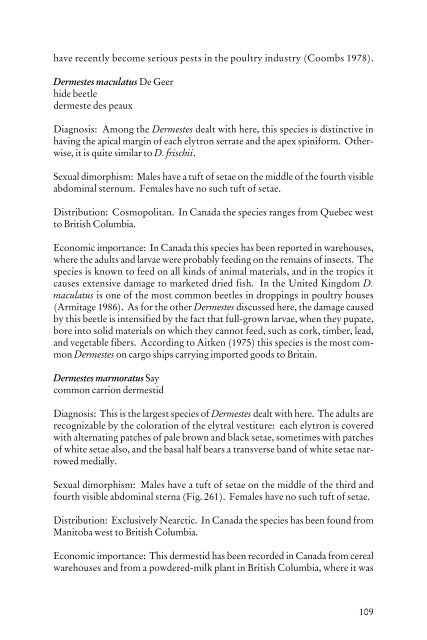Beetles Identification Guide
Beetles Identification Guide
Beetles Identification Guide
You also want an ePaper? Increase the reach of your titles
YUMPU automatically turns print PDFs into web optimized ePapers that Google loves.
have recently become serious pests in the poultry industry (Coombs 1978).<br />
Dermestes maculatus De Geer<br />
hide beetle<br />
dermeste des peaux<br />
Diagnosis: Among the Dermestes dealt with here, this species is distinctive in<br />
having the apical margin of each elytron serrate and the apex spiniform. Otherwise,<br />
it is quite similar to D. frischii.<br />
Sexual dimorphism: Males have a tuft of setae on the middle of the fourth visible<br />
abdominal sternum. Females have no such tuft of setae.<br />
Distribution: Cosmopolitan. In Canada the species ranges from Quebec west<br />
to British Columbia.<br />
Economic importance: In Canada this species has been reported in warehouses,<br />
where the adults and larvae were probably feeding on the remains of insects. The<br />
species is known to feed on all kinds of animal materials, and in the tropics it<br />
causes extensive damage to marketed dried fish. In the United Kingdom D.<br />
maculatus is one of the most common beetles in droppings in poultry houses<br />
(Armitage 1986). As for the other Dermestes discussed here, the damage caused<br />
by this beetle is intensified by the fact that full-grown larvae, when they pupate,<br />
bore into solid materials on which they cannot feed, such as cork, timber, lead,<br />
and vegetable fibers. According to Aitken (1975) this species is the most common<br />
Dermestes on cargo ships carrying imported goods to Britain.<br />
Dermestes marmoratus Say<br />
common carrion dermestid<br />
Diagnosis: This is the largest species of Dermestes dealt with here. The adults are<br />
recognizable by the coloration of the elytral vestiture: each elytron is covered<br />
with alternating patches of pale brown and black setae, sometimes with patches<br />
of white setae also, and the basal half bears a transverse band of white setae narrowed<br />
medially.<br />
Sexual dimorphism: Males have a tuft of setae on the middle of the third and<br />
fourth visible abdominal sterna (Fig. 261). Females have no such tuft of setae.<br />
Distribution: Exclusively Nearctic. In Canada the species has been found from<br />
Manitoba west to British Columbia.<br />
Economic importance: This dermestid has been recorded in Canada from cereal<br />
warehouses and from a powdered-milk plant in British Columbia, where it was<br />
109
















